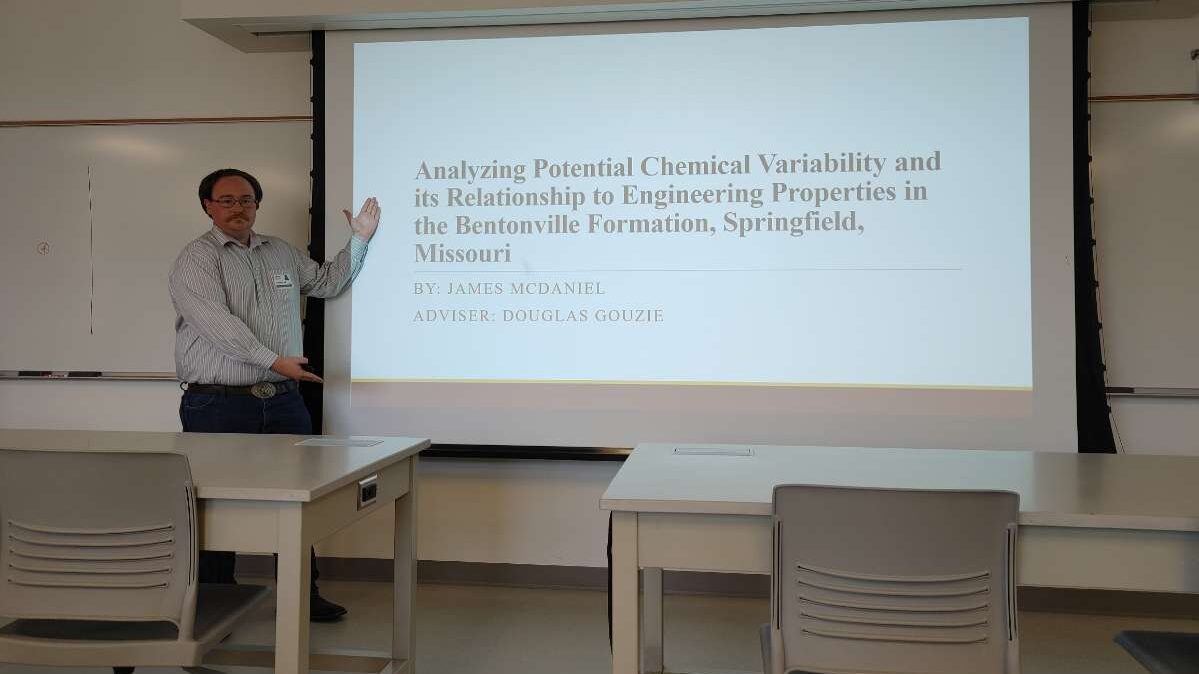The Elsey and Bentonville Formation, also known as the Burlington-Keokuk Formation, are neighboring limestone formations found in southwest Missouri.
Beneath the surfaces of these formations lie chemical variations that are important in the realm of engineering comprehension, making findings about them very valuable.
In honor of his recent discovery, James McDaniel, pursuing an MS in Geography and Geology and an environmental monitoring and sampling certificate, received the Clayton H. Johnson Award from the Association of Missouri Geologists at the 2023 Missouri Academy of Science meeting.
The meeting took place in April at the Missouri Southern State University campus in Joplin, Missouri.
Layers of understanding
McDaniel’s project, titled “Analyzing Potential Chemical Variability and its Relationship to Engineering Properties in the Bentonville Formation, Springfield, Missouri,” explores the possibilities of chemical variations among the formations through an engineering scope.
“In the area between the Elsey formation and Bentonville Formation, I made thin sections of the core to determine the base of the Bentonville Formation, then used 20-foot intervals from the base of the Bentonville Formation to grab about 1 or 2 feet of core in eight total intervals,” McDaniel said. “From there, I cut out pieces of the core, crushed and dissolved the samples, then ran them through an ICP-MS instrument to determine their chemistry.”
McDaniel’s research is one of collaboration. To understand the formation’s engineering properties, the local quarry, Westside Stone, donated aggregate from 20-foot intervals and 5-foot intervals from the base of the Bentonville Formation for him to analyze.
After cleaning and baking the aggregate, he used a Los Angeles (L.A.) Abrasion machine, which is a large rock tumbler used to determine an aggregate sample’s resistance to abrasion.
“I discovered that the top of the Elsey formation, which is the bottom of the Bentonville Formation, was about 1,122 feet above mean sea level for core B-101 in Northwestern Springfield, Greene County,” McDaniel said. “I also found there are significant differences between intervals in the core in iron, zinc and uranium levels, with minor differences in strontium and magnesium variations, and variations in the L.A. abrasiveness in the Bentonville Formation, possibly due to uranium or iron variations seen in the core.”
The conference and award
McDaniel enjoyed his time at the meeting, and even learned some new things.
“It was a nice get together of students and professionals from all over Missouri and all the different sciences to show what they’re doing,” he said. “I was able to learn more about biology, chemistry, astronomy, physics and some geology too.”
The Clayton H. Johnson Award is also dubbed “Best Paper Award,” presented annually to the graduate student with the best research paper at the meeting. McDaniel won this award on the basis of his excellent scientific merit, speaking ability, timing, quality of abstract and responses to questions.
McDaniel’s project is advised and co-authored by Dr. Douglas Gouzie, professor of geography, geology and planning (GGP) at Missouri State.

